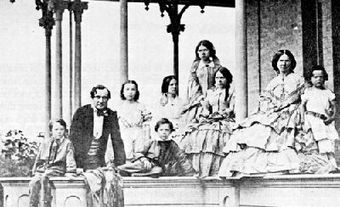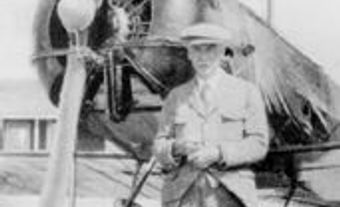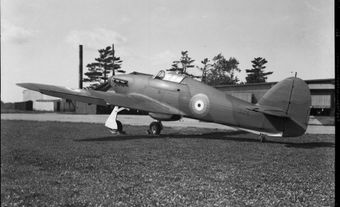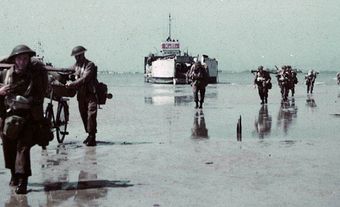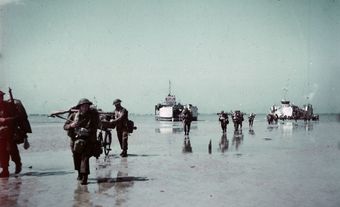Elizabeth (Elsie) Muriel Gregory MacGill, OC, aeronautical engineer, feminist (born 27 March 1905 in Vancouver, BC; died 4 November 1980 in Cambridge, Massachusetts). Elsie MacGill was the first woman to earn a master’s degree in aeronautical engineering (1929). She was also the first practising Canadian woman engineer. In 1938, she became chief aeronautical engineer of Canadian Car & Foundry (Can Car). There, she headed the Canadian production of Hawker Hurricane fighter planes during the Second World War. An active feminist, MacGill was national president of the Canadian Federation of Business and Professional Women’s Clubs (1962–64). She was also a member of the Royal Commission on the Status of Women in Canada (1967–70).
Key Facts
Born 27 March 1905, died 4 November 1980
First woman aeronautical engineer and aircraft designer
Key Canadian feminist
Oversaw production of fighter planes during WWII
Nicknamed “Queen of the Hurricanes”
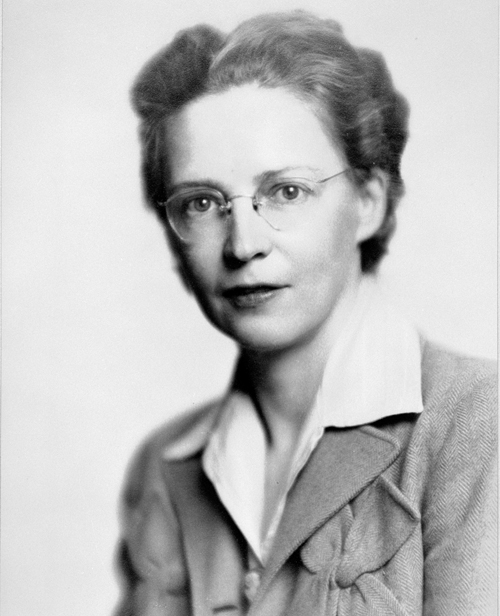
Early Life and Family
Elsie MacGill was born in 1905 in Vancouver, British Columbia. She was the second daughter of Helen Gregory MacGill (1864–1947) and James Henry MacGill (1869–1939). Elsie’s bond with her older sister, Helen Jr., was so close that the family often referred to them as “HelNelsie.” The girls had two older half-brothers, Eric Herbert Gregory and Frederic Philip Gregory. The brothers were from their mother’s first marriage to Frederick Charles Flesher, who died in 1901.
Helen Gregory MacGill was a pioneer in education and a role model for her daughters. She was the first woman in the British Empire to earn her bachelor’s degree in music (1886). By 1890, she had completed Bachelor of Arts and Master of Arts degrees in mental and moral philosophy. After her first husband died, she worked as a journalist to support her two young sons. The following year, she married former classmate James Henry MacGill. He was a journalist, lawyer and deacon of the Church of England. Helen Gregory MacGill also taught herself law. In 1917, she became the first woman judge appointed in British Columbia.
Both parents shared aspects of their legal practice with their family. Helen Gregory MacGill also laid the groundwork for her daughters’ feminist development. The children’s maternal grandmother, suffragist Emma Gregory, helped in this regard. Feminism was, therefore, woven into the children’s lives from an early age. (See also Early Women’s Movements in Canada: 1867–1960.)
Education and Early Career
Elsie MacGill attended public school as a child. She then enrolled in applied science at the University of British Columbia in 1921. She finished her first two years of that program. In 1923, MacGill enrolled at the University of Toronto’s School of Practical Science in electrical engineering. This was a bold move, as she was the first woman admitted to the engineering program. At times, her presence caused quite a stir among her male classmates. However, by graduation, few questions remained about her suitability as an engineer. In fact, MacGill forged many strong friendships with classmates. She maintained lifelong ties with her graduating class, serving prominently within its alumni body.
MacGill graduated in 1927. She found a job as a mechanical engineer with an automobile company in Pontiac, Michigan. Her role focused on stress analysis in automobiles. When the company started making airplanes, she decided to learn more. She started part-time studies in aeronautics at the University of Michigan. Before long, these studies became full-time. In 1929, she completed her master’s degree in aeronautical engineering. This was a groundbreaking step for women. It effectively made MacGill the first woman aeronautical engineer in the world. However, MacGill’s celebration was cut short when she was diagnosed with polio in 1929.
Did you know?
Poliomyelitis (polio) is a contagious viral disease. It can cause paralysis, breathing problems and even death. Major outbreaks of polio occurred in Canada from 1910 until 1959. The worst epidemic (in 1953) resulted in 9,000 paralytic cases and 500 deaths. In the early 1970s, the disease was brought under control by the Salk vaccine and Sabin oral vaccine. In 1994, the country was certified “polio-free.” (See also Canada and the Development of the Polio Vaccine.)
After her temporary confinement to a wheelchair, MacGill spent time recovering at home in Vancouver. In addition to her physiotherapy regimen, she drafted aircraft designs and wrote articles on aviation for popular publications like Chatelaine. She also participated in some of her mother’s feminist activities. The Canadian Federation of Business and Professional Women’s Clubs was among the feminist causes she joined during this period.
Once she was back on her feet, she continued her postgraduate studies at the Massachusetts Institute of Technology (MIT) until 1934. That year, an offer to work as an assistant aeronautical engineer at Fairchild Aircraft Ltd. lured her back to Canada. This was a remarkable opportunity, as jobs were scarce during the Great Depression. The company in Longueuil, Quebec, was doing cutting-edge work. MacGill worked on a variety of aircraft designs and forged important professional ties with the aeronautical staff at the National Research Council of Canada in Ottawa, Ontario. She also showed her bravery by insisting on going up on dangerous test flights to monitor the performance of her designs.
In 1938, two important events occurred in MacGill’s career. First, she took a job as chief aeronautical engineer at Canadian Car & Foundry (Can Car) in Fort William (now Thunder Bay), Ontario. Second, the Engineering Institute of Canada accepted her application for membership. This made her the first woman member of the professional association.
Chief Aeronautical Engineer
Upon her arrival at Canadian Car & Foundry (Can Car), MacGill undertook many projects. One of these projects was the design, construction and testing of the Maple Leaf II Trainer. While the plane was based on a previous model, MacGill completely re-engineered it and did so at impressive speed. She saw the prototype through to aerial testing very early in her tenure at Can Car. The plane never went into full production in Canada. However, it is recognized as the first aircraft designed and produced by a woman.
After this achievement, MacGill oversaw the retooling of the Can Car plant. She equipped it to mass-produce the Hawker Hurricane. The Hurricane was one of the main fighters flown by Canadian and Allied airmen in the Battle of Britain. This was a massive undertaking, and the media was quick to latch onto the fact that a woman was serving as Can Car’s chief aeronautical engineer during wartime. Many articles were written about MacGill. In 1942, the American True Comics series dubbed her “Queen of the Hurricanes” in a story they ran about her.

Did you know?
At Can Car, MacGill oversaw the production of 1,451 Hawker Hurricane planes. She also designed a winterized version with skis and de-icing equipment. This project was the first successful winterization of a high-speed aircraft.
Later Career
The Hawker Hurricane contract ended in 1943. Elsie MacGill once again oversaw the retooling of the Canadian Car & Foundry plant. This time, she equipped it to produce the American Curtiss-Wright Helldiver (a.k.a. “The Beast”). This plane was especially hard to work on because of the many design changes sent from the United States. Amid these design challenges, MacGill and plant manager E.J. (William) Soulsby were marched out of the plant in 1943.
It is not clear whether MacGill and Soulsby resigned from their positions or were dismissed (or for what reasons). Shortly after, the two married and relocated to Toronto, Ontario. Regardless of the reasons that they left Can Car, neither suffered professionally. Soulsby took a new job as plant manager at Victory Aircraft Limited in Malton, Ontario. MacGill went on to found her own successful consulting engineering company. She had strong support from her colleagues at the Engineering Institute of Canada.
MacGill undertook several different contracts that increasingly focused on civilian aircraft. She also became a Canadian representative in the International Civil Aviation Organization (ICAO). Before long, she became the first woman to serve with the ICAO as a technical advisor on aircraft airworthiness.
MacGill was not afraid to question government policy when it came to the balance between civil and military aviation. The 1956 report she submitted to the Royal Commission on Canada’s Economic Prospects is one example of this. In the report, MacGill questioned Canada’s focus on developing military aviation projects at the expense of civil aviation. MacGill’s words of caution seemed justified when the Diefenbaker government cancelled the Avro Arrow in 1959. The demise of this a defence project was disastrous for Canadian aviation.
Feminism
Elsie MacGill was a trail-blazing engineer and prominent Canadian feminist. As a liberal feminist, she believed in change via the reform of existing laws and policies. She also had some radical ideas for the time. For instance, MacGill believed that women should have full control over their own bodies. She therefore considered the issue of abortion a private matter between a woman and her doctor. (At the time, abortion was illegal under the Canadian Criminal Code. It was decriminalized in 1988.)
After her mother died in 1947, MacGill was determined to capture Helen Gregory MacGill’s important achievements. She published My Mother the Judge: A Biography of Helen Gregory MacGill in 1955. This project served to reignite MacGill’s feminist activism. She renewed her work with the Canadian Federation of Business and Professional Women’s Clubs (CFBPWC). Before long, she rose to key leadership roles in the organization. MacGill served as the CFBPWC’s provincial president from 1956 to 1958, and as its national president from 1962 to 1964. In both positions, she championed women’s role in society. In particular, she advocated that Canada would improve with the proper consideration and use of “womanpower.”
From 1967 to 1970, MacGill served on the Royal Commission on the Status of Women in Canada. Her co-commissioners acknowledged her as the leading feminist among them. Chairwoman Florence Bird lauded MacGill’s keen leadership and organizational skills. For the rest of her life, MacGill worked to see as many of the report’s 167 recommendations implemented as possible. She made such efforts on her own and jointly with groups like the National Action Committee on the Status of Women and the Ontario Committee on the Status of Women.
MacGill rejected the label “woman engineer.” Her perspective was that she was an engineer, period. The fact that she was a woman did not need to be highlighted. After all, she had proven time and again that her sex in no way impacted her ability to do her job. MacGill’s rise in engineering had been relatively unchallenged. For most of her career, she was largely blind to any discrimination she experienced. As a result, she did not personally see the engineering profession as discriminatory. And while she supported women taking up science and engineering, this was not the focus of her activism.
It was not until 1970 that she fully realized the challenges women in engineering faced because of their sex. This awareness came following the publication of an article that proposed training women as “engineering aides.” In the article, Dr. F.P.J. Rimrott took a sexist assumption as the basis for his idea of creating this new, subordinate position. Rimrott wrote: “Women favour jobs that do not involve certain duties of which some are, unfortunately, characteristic of engineering, such as design, risk projects, travel, field or shop work, physically and mentally demanding tasks, supervisory functions and major responsibilities.” The controversial article caused an intense debate about women in engineering. It also prompted MacGill to reflect on her own career and acknowledge that she, too, had faced discrimination. She became a vocal critic of discrimination within the profession and a strong advocate of women in engineering. (See also Women’s Movements in Canada: 1960–85.)
On 4 November 1980, MacGill died while visiting her sister, Helen MacGill Hughes, in Cambridge, Massachusetts. Her loss was a shock to all who knew her. At 75 years of age, MacGill had remained active in her career. The previous year, she had received the Association of Professional Engineers Ontario’s highest honour – the Gold Medal. Her continued feminist activism had included support for the UN’s International Women’s Year in 1975 via the CFBPWC. Among other activities, she had been a member of the Advisory Committee for the International Year of Disabled Persons, which was planned for 1981.
Honours and Awards
- Gzowski Medal, Engineering Institute of Canada (1941)
- Award for Meritorious Contribution to Engineering, Society of Women Engineers (1953)
- Canadian Centennial Medal, Government of Canada (1967)
- Officer, Order of Canada (1971)
- Fellow, Engineering Institute of Canada (1972)
- Julian Smith Medal, Engineering Institute of Canada (1973)
- Honorary Doctorate, University of Toronto (1973)
- Amelia Earhart Medal, International Association of Women Airline Pilots (1975)
- Honorary Doctorate, University of Windsor (1976)
- Queen Elizabeth II Silver Jubilee Medal (1977)
- Honorary Doctorates, Queen’s University and York University (1978)
- Gold Medal, Association of Professional Engineers Ontario (1979)
- Inducted into the University of Toronto’s Engineering Hall of Distinction (1980)
- Inducted into Canada’s Aviation Hall of Fame (1983)
- Creation of the Elsie Gregory MacGill Memorial Foundation (1984)
- Inducted into the Canadian Science and Engineering Hall of Fame (1992)
- Inducted into the Women in Aviation International’s Pioneer Hall of Fame (2012)
- Commemorative coin issued by Royal Canadian Mint (2023)

 Share on Facebook
Share on Facebook Share on X
Share on X Share by Email
Share by Email Share on Google Classroom
Share on Google Classroom


